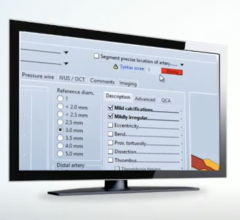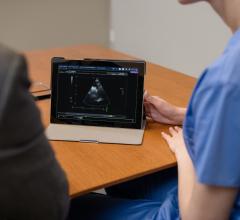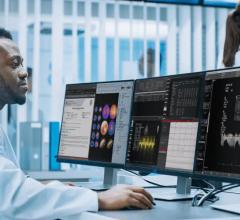
ScImage's PICOM system is an example of a CVIS that unifies the IT needs of several cardiovascular service lines into a single cardiology department reporting and image management system. This includes cardiac imaging, echo, ECG management and cath lab reporting.
Cardiovascular information systems (CVIS or cardiac PACS) have undergone a transformation over the past few years to meet demands for better interoperability, U.S. healthcare reform requirements, and the changing healthcare IT landscape and infrastructure.
In the current market, most of the CVIS vendors are driving their solutions to yield a single point of access with an integrated or single platform comprised of multiple software modules, said Val Kapitula,RT(R), CRT, PMP, a senior consultant at Ascendian Healthcare Consulting. He said majority of vendors are working to consolidate their cath lab reporting, electrocardiogram (ECG) management, hemodynamics, echo PACS (picture archiving and communication systems), nuclear medicine, advanced visualization imaging, and other specialty modalities into a single CVIS. “We have come a long way, but there are vendors that still continue to advance their solutions by consolidating their individual cardiology components into an integrated or single platform,” Kapitula said.
New CVIS Launches
In the past few years, all the major CVIS vendors have completely redesigned new software platforms based on the newest technology trends to move beyond the limitations of their previous systems. Most of the new CVIS platforms are Web-based so they are “zero-footprint” in regards to needing a hard drive to house the software, as with traditional workstations. These platforms also eliminate the need to network all the workstations in a department together, since they can transfer data across the Web. This also eliminated the need for tethered workstations, so now staff can work on any Web-based computer or mobile device, regardless of their location.
The newest of these launches was at the American College of Cardiology (ACC) 2015 meeting, where Philips unveiled its Intellispace CVIS. It uses an icon-based, timeline view of a patient’s medical records instead of a traditional text listing of exam files and reports. The icons offer an immediate way to identify different types of imaging exams, ECGs and cath procedures. Following the trend with the most current CVIS, Intellispace CVIS is a zero-footprint system, enabling Web access from any location without the need for dedicated workstations or computer hard drives.
The new system makes connections to a patient’s cardiology records through the hospital electronic health record (EHR) using URL links to the CVIS information. It also makes extensive use of structured clinical reports in an effort to enable streamlined data mining and analytics. The system has 50 pre-programmed analytical report templates, but Philips said the system allows customers to easily design their own custom reports.
Mobile Device Integration
As smartphones change the way we access data on the go and there is a public expectation for immediate access to information, many CVIS vendors are incorporating mobile device integration into their platforms. This functionality includes the ability to view dynamic ECG waveforms from the emergency department to confirm a STEMI and activate the cath lab, as offered by McKesson and GE Healthcare. Mobile device access to images and reports also enables better patient education at the bedside. Bi-directional data access allows cardiologists to work from any location instead of a dedicated workstation.
Siemens’ syngo Dynamics is among the CVIS offering bi-directional mobile device integration with Android and iPhone/iPad devices. The capability allows cardiac imaging and echocardiograms to be reviewed and imaging and cath lab reports to be completed as the physician has time, whether they are in between procedures, at lunch, at clinic or at home. “Mobile access is making cardiologists more efficient,” said Rik Primo, director strategic relations for Siemens imaging informatics, who has been involved with PACS and CVIS development for more than 30 years.
CVIS in Enterprise Imaging
The new model for how to structure hospital or healthcare system information technology is centered around enterprise imaging. This uses a vendor neutral archive (VNA) for all departments to deposit their data (images, waveforms and reports) into a central location. The VNA uses a content management system to allow any authorized user to access the data. This eliminates the traditional system of numerous departmental siloed systems that generally do not interoperate. This also allows data to easily flow from all departments into a central EHR to create a single, comprehensive record for each patient without needing to access several departmental systems.
This model preserves the use of dedicated, departmental specialty IT systems, such as PACS and CVIS, to operate with an EMR, even if the systems are from different vendors. As the market domination continues to grow for a handful of larger EHR vendors, CVIS vendors will increasingly need to have smooth interoperability with these EHR systems or face replacement.
Kapitula said tight integration with the big EHRs is becoming imperative as the EHR becomes the hub for all patient data. EHRs cannot yet link all the pieces of the cardiology department together, so it offers an opportunity for the CVIS. “With Epic, there are seen integration gaps between hemodynamic systems and other key components of the cardiology department,” Kapitula said. “You need to have a CVIS that integrates tightly with Epic and other top EHRs.” He said other key EHR vendors include Cerner, Allscripts, Meditech and McKesson.
Some CVIS vendors have become vendor neutral by eliminating their EMR products or by using open, non-proprietary programming to enable closer cooperation as partners with larger EHR providers, rather than as competitors. An example of this is Siemens, which no longer offers a hospital-wide EHR system, opting instead to concentrate on detailed departmental IT reporting systems. Other CVIS vendors have followed a similar path, specializing with departmental IT systems so the level of sophistication of their cardiology reporting systems is higher than what is available with the generic cardiac modules offered by EMR vendors.
From a user standpoint in this new business environment, Primo said CVIS vendors need to offer high levels of customer service. This includes intuitive, easy-to-use systems. The systems need to be easily upgradeable so they can meet all the new healthcare reform IT requirements. These systems should enable customers to build custom interfaces. Lastly, he said CVIS need to be Web-based to enable easy, anywhere access.
However, Kapitula said there is still significant amount of work that needs to occur to achieve seamless integration between CVIS and enterprise imaging solution. “In my implementation experiences, I have yet to see flawless integration with a VNA” he explained. “There is no one model that fits an environment directly out of the box; a level of customization is still required to ensure that Image Object Change Management (IOCM) is thoroughly achieved.”
Concerns about the Future
The No. 1 concern from customers today is the consolidation of hospitals, said Steve Tolle, chief strategy officer, Merge Healthcare. He explained mergers create many questions about what to do with legacy systems from various vendors that need to be replaced or integrated. The issues include interoperability, how to reduce the need for multiple logins, the need for one viewer for all modalities and reports, and the need for a centralized archive or VNA.
While the concept of creating an enterprise imaging system is seen as the ultimate goal by many, Tolle said the cost of implementing an enterprise system is a major limiting factor. He explained it is more likely that departments will purchase a replacement PACS, CVIS or VNA, and then fill the gaps as needed when the older systems become obsolete.
Tolle said healthcare payment reform is another big concern among hospitals and a major motivator for procuring new health IT systems. There are numerous new operational requirements for healthcare IT systems under the Stage 2 and Stage 3 Meaningful Use requirements being mandated by the government. Mandates such as computerized physician order entry (CPOE); clinical decision support so imaging exams, tests or procedures meet appropriate use criteria (AUC); sharing images and patient reports freely among clinicians both inside and outside of a hospital; and the need for IT systems that allow bi-directional patient engagement are among the requirements starting in 2018 and beyond.
Primo said using a CVIS enabled with AUC will help reduce the number of Medicare reimbursement denials. In the future, he said AUC will help cardiology departments meet Meaningful Use requirements when AUC documentation becomes mandatory for reimbursements.
Link to GE Healthcare's Interactive, Digital Guide for Centricity Cardio Enterprise


 June 27, 2022
June 27, 2022 








